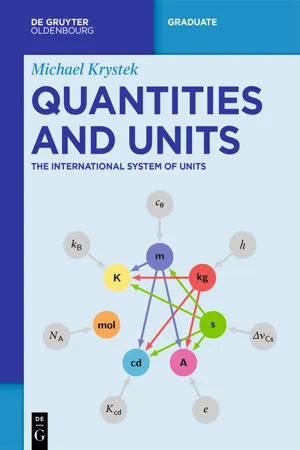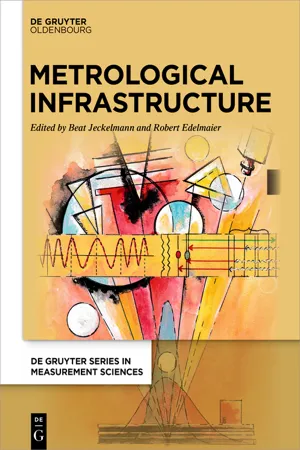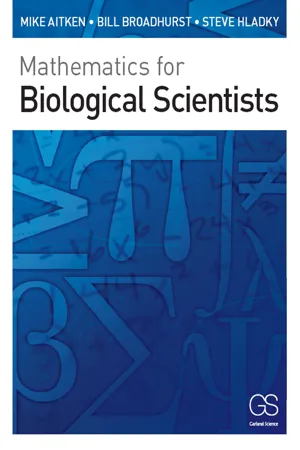Mathematics
Units
In mathematics, units refer to standard quantities used for measuring other quantities. They provide a reference point for comparison and are essential for expressing measurements in a consistent and meaningful way. Units are typically associated with specific dimensions, such as length, mass, time, and temperature, and are crucial for performing calculations and solving problems in various mathematical contexts.
Written by Perlego with AI-assistance
Related key terms
7 Key excerpts on "Units"
- eBook - ePub
The Reform of the International System of Units (SI)
Philosophical, Historical and Sociological Issues
- Nadine de Courtenay, Olivier Darrigol, Oliver Schlaudt(Authors)
- 2019(Publication Date)
- Routledge(Publisher)
The definition of a unit as in equation (4) or equation (5), that does not refer to the relations in the system of quantities, is independent, and dependent is instead a definition, as in equation (6), which does refer to such relations. For example, a definition of length unit based on the relation of length with time and velocity is a dependent definition.2.4 Concepts related to the realization of the definition of quantity Units
The main concepts assumed related to the realization of the definition of quantity Units are:- quantity realizing the definition of a unit;
- object realizing the definition of a unit;
- calibration;
- metrological traceability chain;
- calibration uncertainty.
A measurement process is based on a measurement procedure that specifies a way for comparing the measurand and the unit. This comparison implies the availability of a quantity that realizes the definition of the unit through the realization of a support of that quantity. The object realizing the definition of a unit is called a measurement standard. The comparison with a unit is then generally obtained by realizing a chain of measurement standards, from a primary one to the working standard used in measurement and calibrated against the primary standard through a metrological traceability chain. In the processes of calibration that yields the chain, a calibration uncertainty is produced that generally increases in each step of the chain from the primary standard to the standard involved in the measuring system.3 Basic criteria
The main operative target of the definition of a system of Units is to provide a basis for measurement, for which quantity Units are indeed essential.10 - eBook - ePub
Quantities and Units
The International System of Units
- Michael Krystek(Author)
- 2023(Publication Date)
- De Gruyter Oldenbourg(Publisher)
3 Units 3.1 Systems of Units A system of Units is based on a set of base Units that are assigned to the respective base quantities by convention. The number of base Units of a system of Units is equal to the number of the corresponding base quantities of the underlying system of quantities. The numbers are also always part of every system of quantities. Their unit is the number one, symbol 1. The number one is a special unit because it is the neutral element of multiplication; every unit remains unchanged when multiplied by the number one. Because of this special property, it cannot be a base unit in any system of Units (see [1] for details). All Units for derived quantities are expressed as products of powers of the base Units, fully analogous to the corresponding expressions in the system of quantities. The system of Units and its Units are called coherent if the derived Units are expressed by relations in such a way that all numerical factors are equal to one. Derived Units and their symbols are expressed by the base Units using the mathematical signs for multiplication and division. Some derived Units have been given special names and symbols—mostly for historical reasons—which can also be used to form names and symbols of other derived Units. Since the main purpose of a system of Units is to provide a basis for converting the numerical values of physical quantities whenever the Units are changed, and since quantities of dimension number 17 are invariant under such a conversion, there is no need to include quantities such as the angular measures of the plane angle and the solid angle in the category of basic quantities. For mathematical reasons, this is not even possible, since the unit of all quantities of dimension number is the number one - eBook - ePub
- Beat Jeckelmann, Robert Edelmaier, Beat Jeckelmann, Robert Edelmaier(Authors)
- 2023(Publication Date)
- De Gruyter Oldenbourg(Publisher)
Q can be represented as(1)Q = { Q } [ Q ] .Here,{ Q }is a pure number and[ Q ]denotes the unit used. This representation can be traced back to J. C. Maxwell [14 ]. The formal method for describing the mathematical relations between abstract physical quantities is called “ quantity calculus.” The most important elements in the history of quantity calculus are presented in an article by J. de Boer in 1995 [6 ].Physics maps the real world into abstract models. The physical quantities play the essential role. They are linked by mathematical equations that express the mutual relationships and the physical laws. In mathematical equations, the objects that are related must have the same dimension. This means that quantities with different dimensions can be multiplied but not added. To ensure the balance of dimensions in an equation, dimensional proportional factors (constants) are introduced. It would be impractical to include such constants in every equation. Therefore, in a system of Units, only a few selected quantities have an independent dimension. Here, the system of Units means the set of Units and the rules that are needed to make all quantities measurable. Let us take the volume of a body as an example. It can be expressed as the product of three lengths l, measured in the unit meter (m). The volume is in general formV = k. We can now choosel 3k = 1. This makes the unit of volumem 3and the dimensionL 3 - eBook - ePub
- Subrata Pal(Author)
- 2019(Publication Date)
- Academic Press(Publisher)
Chapter 2Mathematical tools
Abstract
Scientific investigation of the structure and dynamics of a physical object or system requires (a) the measurement of different physical quantities and (b) appropriate mathematical tools. This chapter presents a brief description of the standards of measurement followed by an overview of the mathematical concepts that are important for quantitative analyses of molecular structure and dynamics. Physical systems (including biological systems) and their dynamics are quantitatively described in terms of “observables” or entities which can be measured. The entities are denoted by variables and functions are defined to reveal the interdependence of different variables. The function can be algebraic, trigonometric, etc. and can sometimes be represented by an infinite series. Distinction is made between a scalar quantity with only magnitude and a vector having both magnitude and direction. Changes in the function with respect to the variable/variables on which it depends are discussed in the section on calculus.Keywords
Standards and Units; Functions; Algebra; Trigonometry; Complex variable; Vector; Matrix; Calculus; Series; TransformScientific investigation of the structure and dynamics of an object, be it inanimate or living, requires (a) the measurement of different physical quantities and (b) appropriate mathematical tools. Here, in this chapter, we present a brief description of the standards of measurement followed by an overview of the mathematical concepts that are important for quantitative analyses of molecular structure and dynamics.2.1 Measurements: Standards and Units
Some examples of the physical quantities we may like to measure are mass, volume, density, charge, temperature, and so on. The result of each measurement is a “value” that consists of a number and a unit of measurement. For communication and comparison of the results from different laboratories, it is imperative to have a universally accepted set of standards for Units of measurement. The accepted standards are required to be precise and reproducible, remaining invariable with the passage of time or changes in the environment. - No longer available |Learn more
Technoscientific Research
Methodological and Ethical Aspects
- Roman Z. Morawski(Author)
- 2019(Publication Date)
- De Gruyter(Publisher)
A measurement unit is defined there as a “real scalar quantity, defined and adopted by convention, with which any other quantity of the same kind can be compared to express the ratio of the two quantities as a number” 143. From the today’s science point of view, such understanding of measurement is not general enough to meet the needs of contemporary scientific research. Seeing measurement as a special case of the parametric identification of a mathematical model seems to be the outcome of the development of measurement theory during the last 150 years. Although the history of measurements and measures may be traced back to the ancient Egypt and Mesopotamia, the first mature attempts of theoretical approach to measurement appeared only in the second half of the nineteenth century. In 1887, the German physician and physicist Hermann L. F. von Helmholtz published a small treaty “Zählen und Messen erkenntnisstheoretisch betrachet” 144 which initiated a stream of works aimed at the development of an axiomatic theory of measurement. Those works reached maturity in the period of 20 years separating the publication of a seminal article “A Set of Independent Axioms for Extensive Quantities” 145 (1951) – authored by the American philosopher Patrick C. Suppes (1922–2014) – and the appearance of the first volume of a fundamental handbook Foundations of Measurement 146 (1971). The latter initiated a large-scale synthesis of the so-called representational theory of measurement, the synthesis completed only in 1989–1990 when two consecutive volumes of that handbook appeared 147, 148. In the representational theory of measurement, measurement is defined as the construction of a homomorphism from an empirical relational system E ; r 1 E, r 2 E,... into a numerical relational system N ; r 1 N, r 2 N,... - eBook - ePub
- Ahmad Hemami(Author)
- 2017(Publication Date)
- CRC Press(Publisher)
Almost everything that we need for living is quantified by measurement, from all those items that we count to what we buy by weight, volume, and so on. Electricity is not an exception, and for various entities that we will discuss, measurement becomes essential. You are already aware of many of the measureable items such as weight, length, and time.For measuring anything we need to define a specified quantity of that as the unit of measurement. For instance, one foot is a well-defined unit for length, based on which we can measure and perceive how much, for example, 2, 15, and 1000 ft are. Indeed, without a unit of measure, no measurement can have any meaning.Among all the entities that we measure, some can be considered principal, from which other items can be derived. We have already seen examples of this in the measurement of length: If the unit for measuring length is feet (ft), then for area we can use ft2 and for volume ft3 may be employed. In the metric system we have meter (m) for length, and m2 and m3 for area and volume, respectively. Another example is the unit for measuring speed of something moving. If meter (foot) is the unit for measuring length (or distance) and second is the unit for measuring time, then meters per second (m/sec) or feet per second (ft/s) can be used for the unit of speed.The most common entities that we use in our daily life and measure are length (distance, height), area, volume, speed, acceleration, force, weight (which has the same unit as force), mass, density, energy, time, and temperature. Other specialized measurements depend on the discipline; for example, in physics, mechanics, chemistry, and electricity, there are other entities that need to be measured, and each one has its unit of measure.To measure what we need to measure, a system of measurement is defined, in which the Units are established. There are a few major systems of measurement, some of which are becoming obsolete. Nowadays, the metric system is adopted by most of the industrialized countries. The imperial system (U.S. customary Units) is another system of Units that it is still used in the United States (and some other countries). One of the main objectives of this chapter is to facilitate understanding of the metric system Units and the conversion from the U.S. customary Units to their equivalent metric values for those who are not yet familiar with the metric system. - eBook - ePub
- Mike Aitken, Bill Broadhurst, Stephen Hladky(Authors)
- 2009(Publication Date)
- Garland Science(Publisher)
CHAPTER 1 Quantities and UnitsFigure 1.1The authors, Mike, Steve, and Bill, holding a protein sample destined for the 500 MHz NMR spectrometer in the background. Image courtesy of Mike Aitken, Bill Broadhurst, and Steve Hladky.As scientists, we need to make quantitative statements about the physical quantities measured in our experiments. Algebra provides the language and grammar to make these statements. In this language the sentences are equations or inequalities whereas the words are symbols. A symbol may stand for a physical quantity or a number; for an operation such as addition or multiplication; or for a relationship such as ‘is equal to’ or ‘is greater than’. Often we use letters such as x, t, m, or A to stand for physical quantities such as distance, time, mass, or area. Symbols can also be special characters such as + for addition, or a combination of letters such as ‘sin’ for the sine function introduced in Chapter 4 .A physical quantity is a combination of a numerical value and a unit, for example a length of 1 m, a time of 2 s, or a mass of 70 kg, where the ‘m’ stands for meter, ‘s’ for second, and ‘kg’ for kilogram. Both are needed; if we change the unit the number changes accordingly. Many of the laws of science are expressed as simple equations relating physical quantities. A familiar example is F = ma where F, m, and a stand for force, mass, and acceleration. There are various systems for choosing Units and conventions for how physical quantities are to be described. In this book we use the Système Internationale (SI) system of Units, which has become standard for scientists and engineers throughout the world.1.1 Symbols, operations, relations, and the basic language of mathematicsIn the language of mathematics, the words are symbols like x, t, m, +, ×, ÷, =, >. Symbols can stand for numbers or for physical quantities; they can indicate operations or they can state relationships like ‘is equal to’ or ‘is greater than’. You first started using many of these symbols back in primary school where you learned what + and = mean. Even then you also used symbols to stand for unknown numbers in exercises like that shown in Figure 1.2
Index pages curate the most relevant extracts from our library of academic textbooks. They’ve been created using an in-house natural language model (NLM), each adding context and meaning to key research topics.






